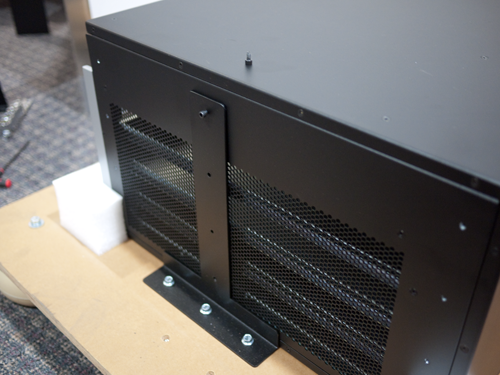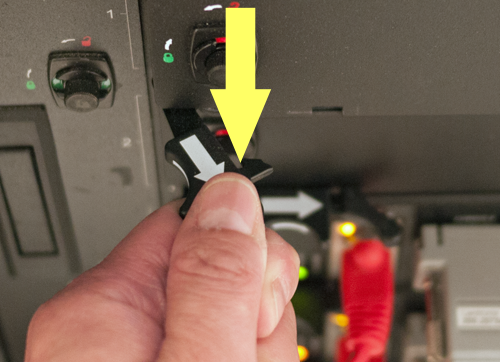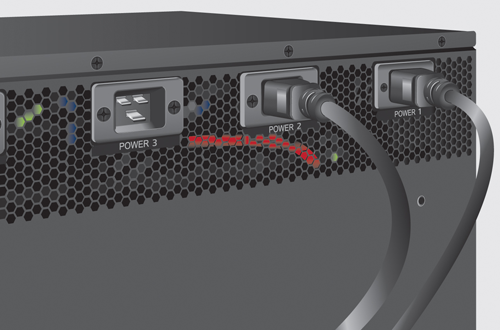Applies To:
Show Versions
Platform Installation
About installing the platform
After you have reviewed the hardware requirements and become familiar with the VIPRION® 4400 Series platform, you can install the chassis.
About general recommendations for rack mounting
Although not required, a 1U empty space between chassis makes it easier for you to remove the chassis from the rack in the event that the chassis requires service. A 1U space between chassis also provides additional cable routing options.
Leaving at least 100 mm of space from the front panel of the chassis to the rack front or rack door provides enough room for you to route the cables without excessive bending or insulation damage.
A shelf or similar device is required to support the chassis if only one person is installing the chassis.
Hardware included with the VIPRION 4400 Series AC chassis
The VIPRION 4400 Series AC-powered chassis should include all of the hardware components listed here.
| Quantity | Hardware |
|---|---|
| 4 | AC power cables, black (C19 to NEMA 6-20P) |
| 4 | AC power cable retention clips |
| 2 | Mounting brackets |
| 4 | Mounting handles |
| 8 | #8-32 1/4 inch black rack mount bracket screws |
| 1 | Front bezel (with LCD component) |
| 1 | Electrical static discharge (ESD) strap |
Hardware included with the VIPRION 4400 Series DC chassis
The VIPRION 4400 Series DC-powered chassis should include all of the hardware components listed here.
| Quantity | Hardware |
|---|---|
| 1 | Two-ring grounding terminal lug, 5/8 inch (1.59 cm) holes on 1.25 inch (3.18 cm) centers |
| 2 | 5/16-18 Keps nuts for the ground |
| 2 | Terminal block plugs for attaching leads to the platform |
| 2 | Quick-install rack mount brackets |
| 8 | Thumb screws |
| 1 | Front bezel (with LCD component) |
| 2 | Cable managers |
Additional equipment for installing the VIPRION 4400 Series DC chassis
This equipment is required to install the VIPRION 4400 Series DC platform.
| Quantity | Hardware |
|---|---|
| 1 | Rack-mounted power disconnect |
| 2 | AWG copper ground wire |
| 8 (minimum) | AWG copper wiring leads for four power supplies |
| 1 | Molex crimping tool for the ground wire |
| 1 | Screwdriver, #2 Phillips head or flat head |
Hardware included with blades
The VIPRION® B4000 Series blades should include all of the hardware components listed here.
| Quantity | Hardware |
|---|---|
| 1 | Console cable, beige (B4100 and B4200 only) |
| 1 | RJ45 to DB9 console port cable, beige (B4300/B4400 only) |
| 1 | RJ45F to RJ45M rolled adapter, beige (B4300/B4400 only) |
| 4 | SFP transceiver modules (B4100 only) |
| 2 | SFP+ 10G transceiver modules (B4200 and B4300 only) |
| 1 | Electrical static discharge (ESD) strap |
Peripheral hardware requirements
For each platform, you might need to provide additional peripheral hardware. If you plan to remotely administer the system, it would be helpful to have a workstation already connected to the same subnet as the management interface.
| Type of hardware | Description |
|---|---|
| Network hubs, switches, or connectors to connect to the platform network interface ports | You must provide networking devices that are compatible with the network interface ports on the platform. You can use either 10/100/1000/10000-Megabit or 40/100-Gigabit Ethernet switches. |
| External USB CD/DVD drive or USB flash drive | You can use a USB-certified CD/DVD mass storage device or a USB flash drive
for installing upgrades and for system recovery.
Note: F5® recommends that
external CD/DVD drives be externally powered.
|
| Serial console | You can remotely manage the platform by connecting to a
serial console terminal server through the console port.
Important: In the event that network access is
impaired or not yet configured, the serial console might
be the only way to access the chassis. You should perform
all installations and upgrades using the serial console,
as these procedures require reboots, in which network
connectivity is lost temporarily.
|
| Management workstation on the same IP network as the platform | You can use the default platform configuration if you have a management workstation set up. |
Unpacking the chassis
About installing the chassis
You should select a location for installing the VIPRION 4400 Series chassis that is easy to access for adding or removing power supplies, the fan tray, or blades. The location should also provide adequate ventilation to allow sufficient airflow through the platform. The platform employs a negative pressure fan system, which draws cold air in from the front and right sides of the chassis and exhausts hot air out the back and left sides of the chassis. After you have identified the intended location for the platform, you can install the chassis into the rack.
The VIPRION 4400 Series chassis includes a rack mount kit and a handle installation kit. The rack mount kit consists of two mounting brackets that you can attach at either the front, middle, or back of the platform, using the screws provided with the chassis. The location at which you attach the brackets depends on the configuration of the rack. The handle installation kit includes four handles and eight screws for attaching the handles to the chassis. The handles make it easier to lift the chassis into position for rack mounting. You must install the rack mount brackets before you can install the handle kit to lift the chassis into position.
The chassis is designed for 19-inch racks. If you are installing into a wider rack, you will need to provide adapters. The four-point rack mounting rail kit will not work with 23-inch racks.
Installing the rack mount brackets
Installing the handle kit

Installing the chassis into a rack
Attaching the front bezel
About installing blades
The VIPRION® C4400 Series chassis supports up to four B4000 Series blades. The VIPRION C4400 chassis supports B4100 and B4200 Series blades. The VIPRION C4480 chassis supports B4200, B4300, and B4400 Series blades. For maximum performance, F5® recommends that you do not mix blade types in a chassis.
When you initially receive the chassis, the slots that can contain these blades are filled with blanks. A blank must be installed in each empty slot to ensure proper thermal management and regulatory compliance. To add a new blade, you first remove the blank from the corresponding slot and then insert the blade. Be sure to keep the blanks in case you need to change the blade configuration later. You should not operate the chassis for an extended period of time without all slots populated.
Removing a blank
Removing a blade
Installing a blade
Blade compatibility
These are the supported VIPRION® 4000 Series chassis/blade configurations.
| Chassis | B4100 Series blade | B4200 Series blade | B4300 Series blade | B4400 Series blade |
|---|---|---|---|---|
| C4400 chassis | x | x | ||
| C4480 chassis | x | x | x |
Blade performance in mixed clusters
If you choose to create a mixed cluster, a system that includes a mixture of VIPRION® blade types, all blades will perform at the same level as the earliest blade model installed in the chassis.
For example, if you have three B4200 Series blades and one B4100 Series blade installed in a chassis, the B4200 Series blades will perform at the same level as the B4100 Series blade. Removing all B4100 blades from a mixed cluster, leaving only B4200 Series blades, enables the B4200 Series blades to perform at their maximum capacity.
Blade software versions in mixed clusters
The behavior of a mixed cluster differs depending on the software versions installed on the blades.
B4200 Series blades in a cluster running BIG-IP version 10.0.x and earlier
If you install a B4200 Series blade into a B4100 cluster running a version of the BIG-IP software that is earlier than version 10.1, you could experience these scenarios:
- You receive an error message in the cluster status for the slot in which the B4200 Series blade is installed, indicating that the blade is running the wrong software version. The software installation status also displays an error for the B4200 Series blade slot.
- Earlier BIG-IP software versions might display in the Configuration utility, but you will not be able to install them to the B4200 Series blade. You receive an installation error message if you attempt to install an earlier version of the BIG-IP software.
- If you upgrade the cluster to version 10.1 or later, the B4200 Series blade joins the cluster as an active member.
- If the B4100 Series blades are subsequently removed from the cluster, the situation does not correct itself automatically, as the system will remember that the version of software for that cluster is a version prior to version 10.1. You can correct this issue by specifying that version 10.1 or later run on the cluster.
- If you move a B4200 Series blade to a second chassis, this does not cause the other chassis to downgrade to a version earlier than version 10.1. Cluster configuration information, which includes the software version information, is tied to the chassis identifier on the chassis hardware and is removed from the blade when it is moved to another chassis.
B4100 Series blades in a cluster running BIG-IP version 10.1 and later
If you install a B4100 Series blade into a chassis with B4200 Series blades running version 10.1 or later, you could experience these scenarios:
- The B4100 Series blade upgrades to the new software and runs (this is the typical, expected behavior).
- The software images previously installed on the B4100 Series blade display as installable in the Configuration utility. If you attempt to install one of those images, you receive an error on the B4200 Series blades, but the installation completes successfully on the B4100 Series blades.
Trunk configuration in mixed clusters
If you replace a B4100 Series blade with a B4200 Series blade in a cluster that uses one or more trunks across the blades, you must adjust the trunk configuration to match the desired B4200 external interfaces. For example, if your trunk uses 10G ports, interface 1.1 on a B4100 Series blade is 10G, and interface 2.1 on a B4200 Series blade is 10G.
For information about configuring your VIPRION system and creating BIG-IP system objects (for example, trunks, VLANS, and self IP addresses), see VIPRION® Systems: Configuration.
Redundant system configuration and mixed clusters
If you have configured device service clustering (DSC™), previously known as a redundant system configuration, and would like to use a mixture of B4100 and B4200 Series blades, you must put the same blade type in the corresponding slots on each chassis. For example, if you install a B4200 Series blade in slot 1 and a B4100 Series blade in slot 2 on the active chassis, you must install a B4200 in slot 1 and a B4100 Series blade in slot 2 in the standby chassis.
About powering the VIPRION 4400 Series AC platform
The AC platform ships with four power cords that you must use with the installed power supplies to power the chassis.
Powering the AC platform
About powering the VIPRION 4400 Series DC platform
If you ordered DC power as a factory option, your VIPRION® 4400 Series platform comes pre-installed with DC power supplies.
Before you power this VIPRION DC platform, see Guidelines for DC-powered equipment and Guidelines for VIPRION DC platform installation.
Additional equipment for powering the DC platform
In addition to the equipment supplied with the standard AC platform, the DC platform requires some additional equipment for installation and wiring. This additional equipment is supplied with the platform.
- Two-ring grounding terminal lug, 5/8 inch (1.59 cm) holes on 1.25 inch (3.18 cm) centers
- Two 5/16-18 Keps nuts for the ground
- Two terminal block plugs for attaching leads to the platform
You need to supply this additional equipment.
- Rack-mounted power disconnect
- 2 AWG copper ground wire
- Minimum 8 AWG copper wiring leads for four power supplies
- Crimping tool for the ground wire
- Screwdriver, #2 Phillips head or flat head
About grounding the chassis
You should ground the platform after you install it in a rack.
Do not secure multiple bonding or grounding connectors with the same bolt. The grounding connectors do not need to be removed to perform service or installation procedures. You can connect other bonding or grounding conductors to a grounding connector provided a reliable bond between the connector and the equipment is not disturbed during installation, service, or maintenance of the platform.

Chassis ground lugs
Connecting the ground lug to the ground terminal
About connecting the DC power source
After the platform is installed in a rack, you can wire the platform to the DC power source. When you connect the DC power source, you should also follow the safety requirements defined for your network operations center (NOC).
There are two groups of terminals on the back of the chassis. When you view the chassis from the rear, there is one on the left side and one on the right side. Each terminal group contains the leads for two power supplies.
- Use the group of leads on the right rear of the chassis labeled PWR 2 and PWR 1 for power supplies 2 and 1.
- Use the group of leads on the left rear of the chassis labeled PWR 4 and PWR 3 for power supplies 4 and 3.

DC terminal block plug
Connecting DC power to the platform
Connecting the cables and other hardware
After you have installed the chassis into the rack, connect the cables and other hardware.
You can now assign a cluster IP address to the system, and then license and provision the software.
Optionally, you should run the latest version of the qkview utility. This utility collects configuration and diagnostic information about your system into a single file that you can provide to F5 Support to aid in troubleshooting. For more information, see http://support.f5.com/kb/en-us/solutions/public/1000/800/sol1858.html.
About cluster management
The management IP address for a cluster is known as the cluster IP address. The cluster IP address enables you to access the browser-based Configuration utility to configure other aspects of the product, such as the product license, VLANs, trunks, and so on. Connecting to the cluster IP address connects you to the primary blade in the system.
With VIPRION® platforms, you assign cluster IP addresses on a per-cluster basis. Initially, all blades installed in the chassis belong to a single default cluster. During the initial setup, you only need to assign a single cluster IP address.
A blade within a cluster is known as a cluster member. You can assign a management IP address to each cluster member.
You can manage clusters using these methods:
- LCD panel
- config utility
- tmsh commands



























